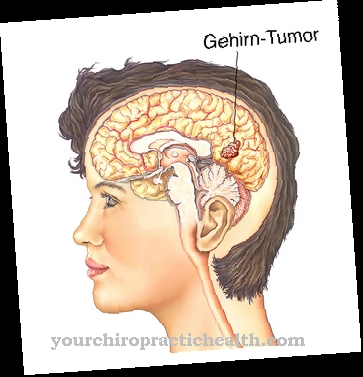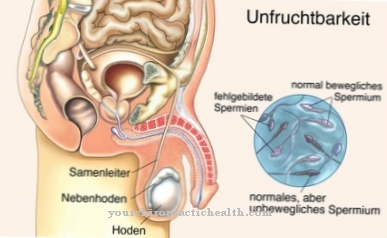Under one Ear infection Doctors understand an inflammatory change in the area of the ear. This can be an inflammation of the outer, middle or inner ear. Depending on where the inflammation is and how severe it is, it can have negative effects on the further health of the person concerned.
What is an ear infection?

© Artemida-psy - stock.adobe.com
An ear infection is also known in medical circles Otitis called. The disease is an inflammation in the area of the ear. A distinction is made here between otitis externa (inflammation of the ear canal), otitis media (otitis media) and otitis interna (inflammation of the inner ear).
The type of ear infection depends on the exact location of the inflamed areas. In most cases, all forms of otitis are expressed as severe earache, which is often accompanied by other symptoms such as fever or hearing loss.
Ear infections should always be treated, otherwise in the worst case scenario they could lead to permanent hearing problems.
causes
The causes of a Ear infection are often caused by bacterial or fungal infection. Basically, the ear canal and all areas of the ear behind it are well protected by fine hairs and ear wax, among other things.
Under certain circumstances, however, pathogens can still get into these sensitive areas and cause unpleasant infections there. The permanent wearing of inner earphones or earplugs can weaken the body's own protection as well as the penetration of water, for example when swimming or showering.
Allergies and eczema around the ears can also lead to otitis. Various childhood illnesses also often lead to an ear infection, especially of the middle ear.
Symptoms, ailments & signs
Inflammation of the ears is common in children, but it is also a very common condition in adults. A typical sign of ear inflammation is sharp and persistent pain. This pain is often quite uncomfortable, so that affected people generally feel very sick and limited.
In most cases, leakage of pus fluid is also a clear symptom and sign of a serious inflammation in the ear canal. If such a clinical picture remains without medical and drug treatment, then a significant worsening of the symptoms can be expected. In many cases, headaches and body aches are associated with an ear infection, so that the person concerned feels a general malaise.
Only those who initiate medical and drug treatment at an early stage can count on a quick and complete recovery. However, in rare cases, ear infection is not caused by bacteria. Inflammation can also be caused by a foreign object in the ear canal.
This also leads to severe pain, so that under certain circumstances permanent damage can occur. Those who decide early on for professional treatment can nip the symptoms described here in the bud. Otherwise a significant worsening of the individual symptoms can be expected.
Diagnosis & course

A Ear infection in most cases it is noticeable as moderate to severe pain. If the person concerned then see a doctor, he will take a closer look in the ear.
With the help of the so-called otoscope, he can examine the inside of the ear and often make a diagnosis in this way. In addition, a full blood test may be done to confirm the presence of inflammation. If fluid leaks, a smear can provide additional important information.
If an ear infection is left untreated, it can, in the worst case, lead to permanent hearing loss. Internal otitis in particular can spread to the brain and cause severe consequential damage.
Complications
The complications that can occur with an ear infection depend on which section of the sensory organ is affected by the infection. Most likely, complications are to be expected from untreated or untreated inflammation of the middle ear. Acute otitis media is a medical emergency. The possible complications are divided into the categories extracranial (outside the skull) and intracranial (inside the skull).
A common extracranial complication that primarily affects children is mastoiditis. This is a purulent inflammation of the skull bone behind the ear. In addition, there is a risk of inflammatory facial paralysis (facial paralysis) as the bone canal of the seventh cranial nerve runs close to the middle ear. This nerve controls the facial expressions.
If the inflammation spreads from the middle ear to the nerve, this can lead to one-sided paralysis. Those affected lose control of one side of the face, usually temporarily, and are disfigured by the corners of their mouth and eyes sagging.
Otogenic meningitis is one of the dangerous intracranial complications. Meningitis forms when the pathogens reach the meninges via the labyrinth in the ear or the blood vessels and infect them. In addition, intracranial abscesses, i.e. accumulations of pus inside the skull, can form, which can be life-threatening. If mastoiditis occurs, sinus vein thrombosis cannot be ruled out.
When should you go to the doctor?
Ear pain that persists for several days should be evaluated. With an ear infection, those affected often describe a sharp pain that occurs suddenly. If the symptoms increase or spread, a doctor should be consulted immediately. In addition, you should refrain from taking pain relieving medication until you have consulted a doctor. There is a risk of side effects which should be avoided if possible. A pulling or whistling feeling inside the ear, unusual noises in the ear or disturbances of the balance are signs of an irregularity that need to be clarified.
If the person affected suffers from unsteadiness, dizziness or an increased risk of falling, a doctor is required. Headaches or a feeling of pressure are also a cause for concern. If pus or a foreign fluid forms inside the ear, this is an indication of an existing disorder. A fever, general malaise or an unpleasant odor in the ear should be presented to a doctor. If hearing impairment occurs or if noises from the environment are perceived as muffled, a doctor's visit is necessary. A strong feeling of illness, indifference or a loss of the usual physical and mental performance are signs of a health disorder. You should be presented to a doctor so that the cause can be clarified.
Treatment & Therapy
Does the treating doctor (usually an ENT doctor) have one Ear infection if diagnosed, he will initiate appropriate treatment. This depends particularly on which area of the ear is affected and what exactly caused the infection.
In the case of bacterial inflammation, an antibiotic is most likely prescribed to fight the bacteria and prevent the infection from re-germinating.A fungal infection of the ear is treated with an antifungal agent. With inflammation of the ear canal, the drug can be applied in the form of an ointment; If the infection is deeper, tablets must be taken.
In addition, the healing process can be supported with heat applications, for example red light. A middle ear infection can also be caused by a tear in the eardrum. Surgical intervention may be necessary here. This also applies if there is chronic inflammation of the middle ear and the bone structure of the ear is attacked by the infection.
In the case of otitis externa, surgery is necessary, for example if a large accumulation of pus has formed that must be removed. If an ear infection is treated professionally in good time, it usually has no consequences for the hearing ability or the health of the person concerned.
You can find your medication here
➔ Medicines for earache and inflammationOutlook & forecast
The prognosis of an ear infection, also known as otitis, depends not only on the patient, but also on the type of illness. The outlook for the simplest form of outer ear infection is good. With timely medical treatment, the symptoms improve within a few days without consequences. However, if the reaction is too late, the inflammation can spread to the auricle. Inflammation of the entire ear canal also heals in a few weeks without any consequences. In rare cases, there is a life-threatening risk if it changes to a more severe form. In diabetics, there may be more recurrence.
Otitis media also generally has a good prognosis and heals within a few days without any consequences. If the disease becomes chronic or complications arise, the inflammation can spread to the brain. Small children are particularly at risk. Repeated infections can lead to hearing loss, which has a negative effect on language development.
Inner ear infection also has good prospects if treated early. Then there will be neither complications nor permanent damage. However, there are some risk groups. Children have a worse prognosis because their ear canals are still growing. In rare cases, hearing can be permanently damaged. Pregnant women or people with previous illnesses are also particularly at risk.
prevention
One Ear infection, especially in the outer area, can be prevented in different ways. For example, the ear canal should not be cleaned with cotton swabs to prevent pathogens from entering. If a lot of ear wax builds up regularly, the ear canal should be cleaned by a doctor to prevent infections. If the first signs of otitis appear, a doctor should be consulted at an early stage in order to initiate appropriate therapy and to rule out late effects.
Aftercare
An ear infection usually heals completely with appropriate therapy. Since there is then no symptoms, there is no reason for follow-up care. The patient can go on with his normal life but should take preventive measures. Because the body does not build up immunity to an ear infection.
Above all, ear protection against wind and weather prevents a new illness. The patient is responsible for this in his or her everyday life. The doctor may impart relevant knowledge as part of the initial therapy. The treatment is different for chronic ear infections. Permanent aftercare is necessary here.
The doctor tries to prevent constant infections and hearing loss through a close examination rhythm. For this purpose, control appointments are arranged individually. The otoscope and a blood test are suitable for determining the healing process. The patient initially takes antibiotics. An operation may then be necessary.
Follow-up care for an ear infection thus partly pursues different goals than for cancer. Because an ear infection cannot recur after successful therapy. There is also no life-threatening situation. In contrast, both forms of the disease are about avoiding complications and providing everyday support. The longer you have an ear infection, the more important competent follow-up care becomes.
You can do that yourself
An ear infection usually goes away after a few days. The sick person can promote recovery by taking sufficient care of himself and protecting the affected ear from further stimuli. Physical exertion and stress should be avoided. Home remedies such as leg wraps are ideal if your body temperature rises. The sore ear can be treated with onion bags or cherry stone pillows. Red light is also often used in an ear infection.
Alternatively, herbal remedies can help, for example homeopathic ear drops or ointments with glycerine. Ventilation tubes, which are inserted into the ear under anesthesia and allow ventilation of the narrowed ear canal, are also particularly effective. Ventilation tubes are particularly useful for chronic middle ear infections or if the child has poor hearing and shows signs of fever.
If the symptoms have not subsided after a maximum of three days or even worsen, a doctor must be consulted. In consultation with the doctor, further measures can be taken to cure the inflammation quickly. The patient should have another check-up a few days after recovery to ensure that the inflammation has completely subsided.

.jpg)



.jpg)



















.jpg)

.jpg)
